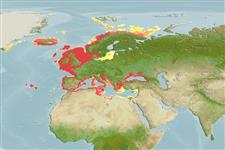Common names from other countries
Classification / Names / Names
ماع يماسا | فدارتم | Catalog of Fishes (gen., sp.) | ITIS | CoL | WoRMS
Environment: milieu / climate zone / depth range / distribution range
يسانش موب
; قمع تارييغت 0 - 250 m (Ref. 78574). Subtropical; 73°N - 21°N, 33°W - 42°E
Northeast Atlantic and the Mediterranean.
Length at first maturity / Size / Weight / نس
Maturity: Lm ? range ? - ? cm Max length : 1.0 cm TL يسنج صاوخ نودب / رن سنج; (Ref. 78574)
Collected from the sublittoral zone, from low tide up to a depth of 200 m (Ref. 2754). A microalgae herbivore (Ref. 96488). This is an epibenthic species found on reefs (Ref. 95730). It is one of the most abundant microgastropods inhabiting the alga Gelidium latifolium and prefers to live at the base of the plant (Ref. 96520).
Life cycle and mating behavior
غولب | لثم دیلوت | یزیر مخت | اه مخت | Fecundity | )ورال ( دازوت
Members of the order Neotaenioglossa are mostly gonochoric and broadcast spawners. Life cycle: Embryos develop into planktonic trocophore larvae and later into juvenile veligers before becoming fully grown adults.
یلصا ذخآم
عجارم | هدننك گنهامه | ناراكمه
Demir, M. 2003. (Ref. 2754)
NCUI زمرق تسرهف رد تيعضو (Ref. 130435)
ستياس رظن زا تيعضو (Ref. 108899)
Not Evaluated
Not Evaluated
یناسنا هدافتسا
| FishSource |
اهرازبا
رتشيب تاعالطا
Age/Size
دشر
نزو - لوط
لوط - لوط
يسانش تخير
)ورال ( دازوت
يناوارف
يتنرتنيا عبانم
Estimates based on models
Preferred temperature
(Ref.
115969): 6.7 - 15.7, mean 9.8 (based on 632 cells).
یريذپ بيسآ
Low vulnerability (10 of 100).
تميق هقبط
Unknown.
